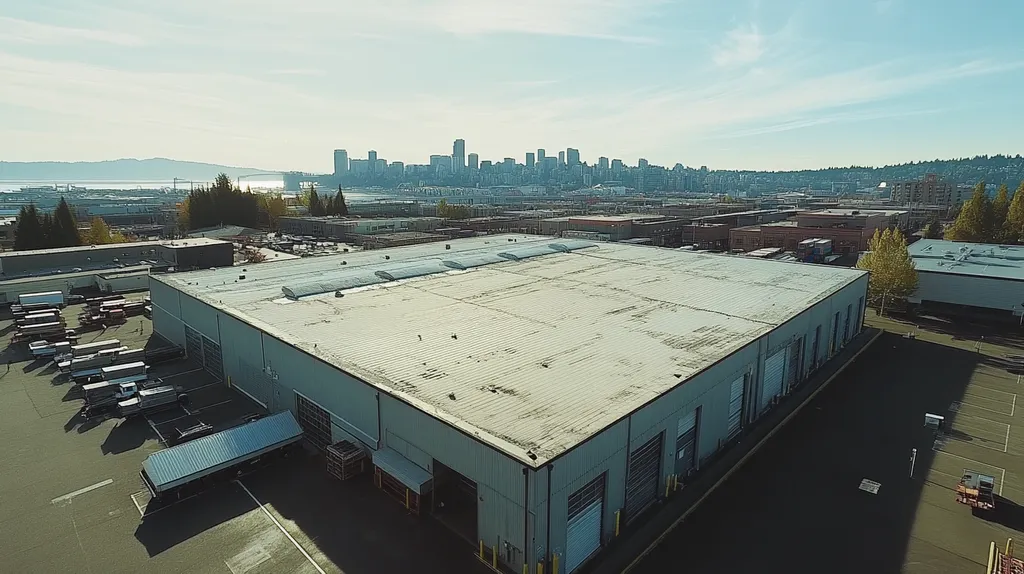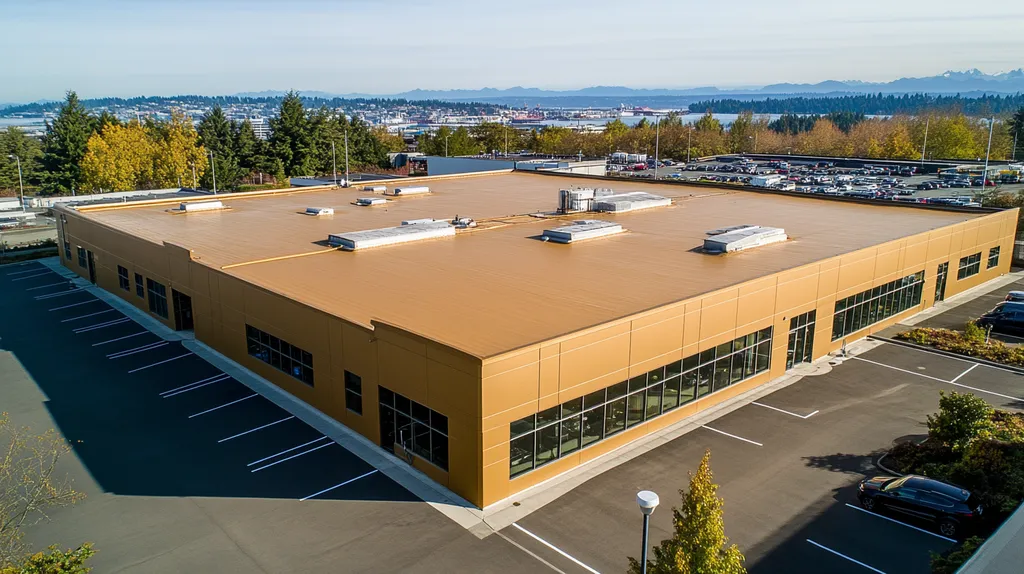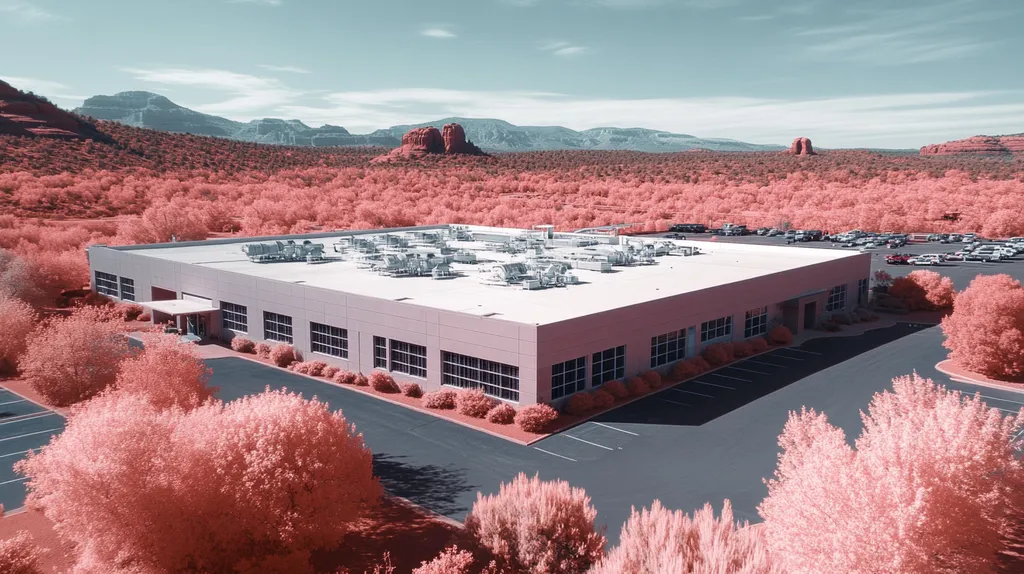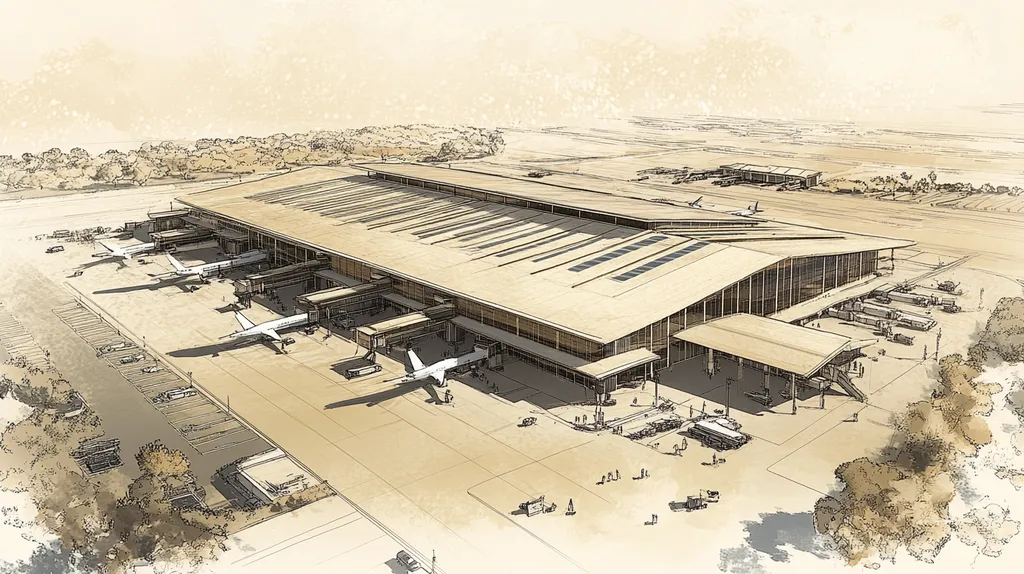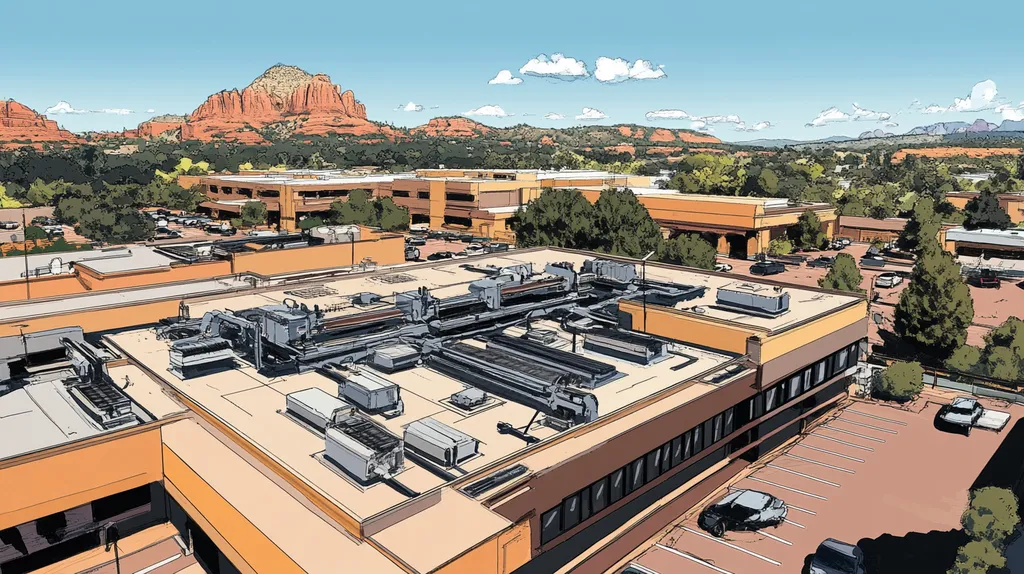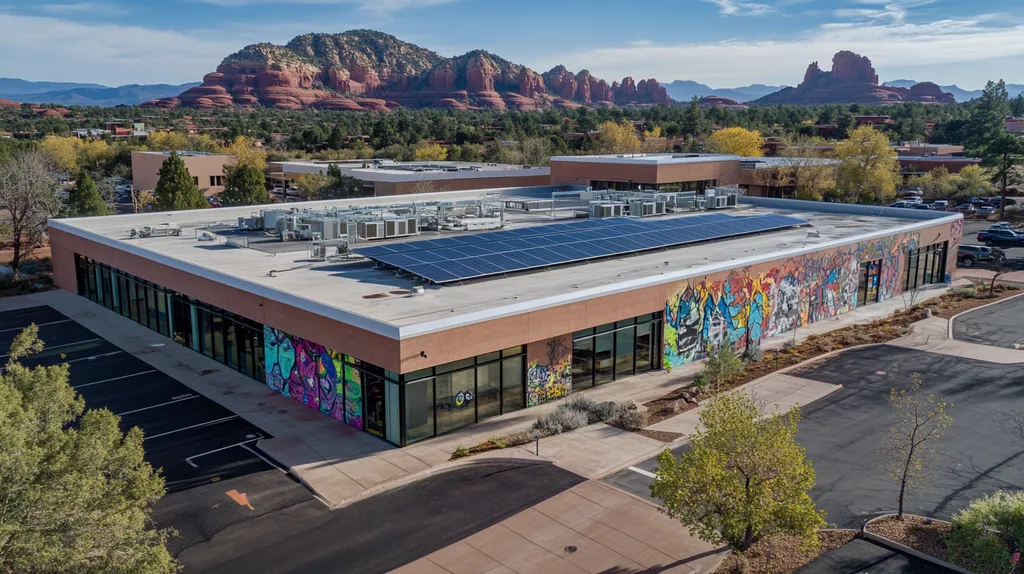In industrial facilities, roof coating failures cost businesses over $2.5 billion annually in emergency repairs, equipment damage, and operational disruptions. Recent studies indicate that 40% of these failures stem from misconceptions about emergency coating solutions.
The consequences of improper coating selection or application extend far beyond simple leaks, threatening critical equipment and production continuity.
This analysis examines common myths surrounding industrial roof coatings, their practical implications, and evidence-based approaches that protect valuable assets while maintaining operational integrity.
SECTION 1: COMMON MISCONCEPTIONS
Industrial facility managers face critical decisions when addressing roofing emergencies, yet misconceptions about coating solutions often lead to costly mistakes. Studies show that improper coating selections or applications result in up to 40% shorter roof lifespans and significantly higher maintenance costs. Understanding the reality behind common myths is essential for protecting valuable industrial assets and maintaining operational continuity.
Emergency Coatings Are Just Temporary Patching
Modern emergency coating systems represent sophisticated engineered solutions that provide long-term protection. Advanced polymer formulations create durable barriers that actively prevent moisture infiltration and UV degradation.
These coatings incorporate elastomeric properties that allow for thermal expansion and contraction, maintaining their protective qualities through extreme temperature variations. This flexibility prevents cracking and separation commonly associated with traditional patch repairs.
Professional-grade emergency coatings can be applied rapidly without compromising their protective qualities. The speed of application serves operational needs while delivering lasting performance benefits.
When properly selected and installed, emergency coating systems integrate seamlessly with existing roofing materials, creating a reinforced protective layer that extends roof life significantly.
All Coating Materials and Application Methods Are the Same
Materials vary widely in durability, lifespan, and maintenance needs, significantly impacting long-term costs. While some lower-quality coatings may deteriorate within a decade, premium solutions can protect industrial roofs for over 40 years with proper maintenance. (source: Castagra Products, Inc.)
Different coating chemistries serve distinct purposes – silicone-based products excel in ponding water resistance, while polyurethane formulations offer superior impact resistance and chemical protection.
Application methods must match both the coating type and substrate characteristics. Professional installation techniques, including proper surface preparation and environmental controls, directly influence coating performance.
Temperature, humidity, and substrate condition requirements vary significantly between coating systems, making proper selection crucial for success.
Roof Coatings Are Only for Visual Improvement
Industrial roof coatings deliver substantial functional benefits beyond aesthetic enhancement. These systems create seamless waterproof barriers that prevent moisture infiltration and subsequent structural damage.
Advanced coating formulations incorporate reflective properties that significantly reduce thermal load. This characteristic can decrease cooling costs by 15-25% in industrial facilities.
Protective coatings actively resist chemical exposure, UV degradation, and mechanical stress. This multi-functional protection extends roof service life while reducing maintenance requirements.
Modern coating systems also provide environmental benefits through reduced waste, as they can often be recoated rather than replaced, supporting sustainable facility management practices.
SECTION 2: PRACTICAL IMPLICATIONS
When industrial roofing emergencies strike, every minute of delay compounds potential damage. Understanding the practical implications of coating solutions becomes crucial as water infiltration can compromise structural integrity within hours. Studies indicate that proper emergency response can prevent up to 85% of consequential damages, while misinformation-driven delays often result in exponentially higher repair costs and extended operational disruptions.
How Misinformation Delays Urgent Repairs
Many maintenance and engineering managers face critical decisions impaired by misconceptions about fluid-applied roof coating systems. These misconceptions often stem from outdated information or misleading sales tactics, causing hesitation when swift action is required. (source: Facilities Management Insights)
Confusion about coating compatibility with existing roof systems frequently leads to paralysis in decision-making. This uncertainty can extend repair timelines from hours to weeks, allowing minor issues to escalate into major structural problems.
Weather-dependent application requirements often become another source of delay. Without proper understanding of modern coating technologies, managers may unnecessarily postpone repairs during viable application windows.
Misinformation about cure times and immediate weather resistance can result in poorly timed applications. These timing mistakes frequently lead to coating failures and the need for complete reapplication.
Impact on Structure and Equipment During Emergencies
Water infiltration through compromised roofing can rapidly deteriorate structural elements. Steel components can begin showing signs of corrosion within 48 hours of exposure, while wooden structures may experience immediate swelling and weakening.
Sensitive electronic equipment and control systems face immediate risk from even minor leaks. A single drop of water in the wrong location can trigger system failures worth hundreds of thousands in damages and lost production.
Inventory damage represents another critical concern during roofing emergencies. Products stored in warehouses can suffer complete loss from relatively minor leaks, especially in facilities handling moisture-sensitive materials.
The presence of hazardous materials or processes adds another layer of urgency. Roof leaks near chemical storage or processing areas can create dangerous conditions requiring immediate facility shutdown.
Risk of Short-Term Fixes Becoming Long-Term Failures
Temporary repairs without proper surface preparation often create adhesion failures within months. These failures typically occur at the worst possible times, such as during severe weather events when emergency services are already stretched thin.
Improper coating selection for specific substrates can create hidden moisture traps. These traps accelerate deterioration beneath the coating, leading to extensive hidden damage that becomes apparent only when repair costs have multiplied.
Quick fixes that ignore underlying structural issues mask progressive deterioration. What begins as a simple leak can evolve into complete system failure requiring full replacement rather than repair.
The cumulative cost of repeated temporary repairs often exceeds proper emergency coating solutions by 300-400%. This cycle of repetitive repairs creates ongoing disruption while failing to address root causes.
SECTION 3: COST OF MISINFORMATION
The financial impact of misinformation about emergency roof coatings reaches far beyond initial repair costs. Industry data reveals that poorly informed coating decisions lead to premature system failures in 40% of industrial facilities within the first three years. These failures create a cascade of expenses, from emergency repairs to equipment damage and production losses, often exceeding ten times the cost of proper initial solutions.
Misguided Investment in Ineffective Emergency Solutions
The true cost of selecting inappropriate emergency coating solutions extends well beyond the initial purchase price. When factoring in application costs, equipment mobilization, and facility disruption, even a single failed coating application can represent a six-figure expense for large industrial facilities.
Many facility managers fall victim to deceptively low-cost solutions that fail to address underlying issues. The cost of tearing off and replacing a roof system can be staggering, while restoring a roof at one-half the cost of replacement using appropriate coatings represents a more strategic investment. (source: Facilities Net)
Emergency coating failures often trigger a cycle of repetitive repairs, each attempt further depleting maintenance budgets. These successive repair attempts typically cost 3-4 times more than implementing a comprehensive solution initially.
The financial impact extends to insurance premiums and warranty coverage, as repeated failures may lead to coverage restrictions or increased deductibles. This creates additional long-term financial exposure for facility owners.
Additional Downtime and Operational Disruptions
Failed emergency coating applications frequently necessitate complete production shutdowns for remediation. These unplanned stoppages can cost industrial facilities between $5,000 and $50,000 per hour depending on their operations.
Secondary impacts ripple through supply chains as production delays affect downstream customers. Many facilities face contractual penalties or lost business opportunities due to extended downtime from coating failures.
Emergency recoating operations often require extensive preparation time, including equipment relocation and production line modifications. These preparatory steps multiply downtime costs while creating logistical challenges throughout the facility.
The cumulative effect of repeated coating failures creates scheduling uncertainty that impacts workforce management and customer relationships. This operational instability can persist for months after each incident.
Potential for Accelerated Roof System Deterioration
Inappropriate emergency coatings can trap moisture within existing roofing systems, accelerating deterioration of structural components. This hidden damage often progresses undetected until catastrophic failure occurs.
Chemical incompatibility between emergency coatings and existing roof materials can create reaction zones that compromise system integrity. These interactions may void existing warranties while creating new vulnerabilities.
Poor coating selections often lead to inadequate protection against UV exposure and thermal cycling. This accelerates the breakdown of both the coating and underlying roofing materials, shortening system lifespan by up to 60%.
The combination of trapped moisture and compromised protection typically reduces roof system life expectancy by 15-20 years. This premature aging creates substantial capital expenditure requirements that could have been avoided through proper emergency coating selection.
SECTION 4: REALITY CHECK
Industrial facility managers facing emergency roof situations must navigate complex decisions about coating solutions while protecting millions in assets. Data shows that properly selected and applied emergency coatings can extend roof life by 10-20 years, while poor choices often lead to system failure within months. Understanding the true capabilities, limitations, and implementation requirements of these systems is crucial for making informed decisions that protect both infrastructure and operations.
True Lifespan and Restoration Potential of Emergency Coatings
Modern emergency coating systems deliver measurable performance benefits when properly specified and installed. Silicone-based coatings demonstrate exceptional UV stability and resistance to ponding water, while urethane formulations provide superior durability under harsh industrial conditions.
Hybrid coating systems combining multiple chemistries offer enhanced protection by leveraging the strengths of different formulations. These sophisticated solutions create robust barriers against moisture infiltration while maintaining flexibility through thermal cycles.
Professional-grade coating systems typically come with 10-20 year warranties, reflecting manufacturer confidence in their restoration potential. However, this performance depends heavily on proper surface preparation and application techniques. (source: Facilities Management Insights)
Environmental conditions significantly impact coating performance and longevity. Temperature extremes, chemical exposure, and mechanical stress must be considered when selecting appropriate solutions.
Proven Cases of Coating Success in Industrial Environments
Large-scale manufacturing facilities have demonstrated significant operational benefits from emergency coating implementations. Documentation shows properly applied systems reducing leak-related downtime by up to 95% while extending roof service life beyond initial projections.
Food processing plants report particular success with specialized coating systems that maintain FDA compliance while protecting sensitive production areas. These applications often pay for themselves within 18 months through reduced maintenance costs and enhanced operational reliability.
Distribution centers utilizing reflective coating systems consistently report energy savings between 15-30% during peak cooling seasons. This benefit compounds the protective aspects of emergency coating solutions.
Chemical processing facilities have successfully employed chemical-resistant coating formulations to protect roof systems from aggressive vapors and occasional spills. These specialized applications often extend roof life by 8-12 years in extremely harsh environments.
The Role of Professional Application and Maintenance Protocols
Surface preparation represents the most critical factor in coating success. Professional contractors employ sophisticated cleaning and preparation protocols that directly impact coating adhesion and long-term performance.
Application temperature, humidity controls, and cure time monitoring significantly influence coating integrity. Professional installers maintain strict environmental controls throughout the application process to ensure optimal results.
Regular inspection protocols help identify potential issues before they compromise coating performance. Establishing comprehensive maintenance schedules extends coating life while protecting the underlying roof system.
Documentation of application conditions, maintenance activities, and periodic assessments creates accountability while supporting warranty compliance. This systematic approach helps facility managers maximize their emergency coating investments.
SECTION 5: EVIDENCE-BASED ALTERNATIVES
Industrial facility managers face critical decisions when emergency roof issues arise, with each passing hour increasing the risk of catastrophic failure. Studies show that water infiltration can compromise structural integrity within 48 hours, making rapid yet informed response essential. Modern coating technologies offer sophisticated solutions, but success depends on selecting appropriate systems and following rigorous application protocols.
Selecting the Right Coating System for Industrial Emergencies
When fluid-applied systems are properly specified and installed, they can match or exceed the performance of original roofing materials. Performance data shows that modern coating systems can extend roof life by 15-20 years while providing superior protection against environmental stresses. (source: FacilitiesNet)
Chemical composition determines coating performance in specific environments. Silicone-based systems excel in UV resistance and weather protection, while polyurethane formulations provide superior mechanical strength and chemical resistance.
Substrate compatibility plays a crucial role in coating effectiveness. Modern systems offer specialized primers and base coats that optimize adhesion to various roofing materials, from metal to modified bitumen.
Environmental factors significantly influence coating selection. Regional weather patterns, facility emissions, and exposure conditions must align with coating capabilities to ensure long-term performance.
Best Practices for Preparation, Application, and Curing
Surface preparation represents the foundation of coating success. Professional contractors employ multi-step cleaning protocols that remove contaminants, repair damage, and create optimal bonding conditions.
Temperature and humidity controls during application directly impact coating performance. Sophisticated monitoring systems ensure environmental conditions remain within manufacturer specifications throughout the installation process.
Application thickness and coverage rates require precise measurement and control. Modern spray equipment provides digital monitoring capabilities that maintain consistent material distribution.
Curing protocols must account for facility operations and environmental conditions. Staged application strategies allow for continuous facility operation while ensuring proper coating development.
Integrating Coatings Into Broader Roof Asset Management
Emergency coating solutions must align with comprehensive asset management strategies. Regular inspections and performance monitoring help identify potential issues before they compromise coating integrity.
Documentation systems track coating performance metrics, maintenance activities, and environmental exposure. This data supports warranty compliance while informing future coating decisions.
Staff training programs ensure maintenance personnel understand coating limitations and inspection requirements. Regular updates keep teams current with evolving coating technologies and best practices.
Integration with facility management software enables predictive maintenance scheduling. This systematic approach optimizes coating life while minimizing emergency repair scenarios.
SECTION 6: TEST AND VERIFY
Inadequate testing of emergency roof coatings costs industrial facilities millions annually in premature failures and repeated repairs. Recent studies show that over 40% of coating failures stem from improper verification during installation, while thorough testing protocols can extend coating life by 15-20 years. For facility managers, understanding and implementing proper testing methods represents the critical difference between long-term protection and catastrophic failure.
Field Testing and Inspection Methods for Coating Performance
Comprehensive field testing begins before coating application through substrate analysis and moisture detection. Modern inspection tools like infrared scanning and nuclear moisture meters identify hidden issues that could compromise coating performance.
Environmental monitoring during application ensures conditions meet manufacturer specifications. Digital systems track temperature, humidity, and dew point continuously, allowing real-time adjustments to maintain optimal application parameters.
Post-application testing includes visual inspections for holidays, pinholes, and surface defects. Advanced imaging technologies detect microscopic flaws invisible to the naked eye but capable of compromising system integrity.
Regular performance monitoring through scheduled inspections helps identify potential issues before they develop into serious problems. This proactive approach supports warranty compliance while maximizing coating service life.
Verification of Dry Film Thickness and Adhesion
Dry film thickness measurements using calibrated electronic gauges provide crucial data about coating uniformity and coverage. Regular measurements during application ensure proper material distribution and help prevent weak spots in the protective barrier.
Adhesion testing through standardized pull-off methods quantifies the bond strength between coating and substrate. These tests verify proper surface preparation and primer effectiveness while predicting long-term performance potential.
Systematic mapping of test results creates comprehensive documentation of coating consistency across the entire roof surface. This data supports quality control efforts while establishing baseline measurements for future comparisons.
Laboratory analysis of coating samples validates material properties and cure characteristics. These tests confirm proper chemical reactions and final coating properties essential for long-term performance.
Documentation and Compliance with Industry Standards
Digital documentation systems track every aspect of coating verification from initial testing through final inspection. This comprehensive record-keeping supports warranty claims while providing crucial data for maintenance planning.
Standardized testing protocols ensure consistency and reliability in performance verification. Professional coating inspectors follow established procedures that align with ASTM and other industry standards.
Quality control documentation includes detailed reports of surface preparation, application conditions, and final testing results. These records provide accountability throughout the coating process while supporting regulatory compliance.
Maintenance tracking systems integrate testing data with broader facility management protocols. This systematic approach helps optimize coating performance while preventing unexpected failures through early detection of potential issues.
The Bottom Line
Emergency roof coating failures cost industrial facilities over $2.5 billion annually, yet 40% of these incidents stem from preventable errors in selection, testing, and verification.
Modern coating technologies offer sophisticated solutions that can extend roof life by 15-20 years when properly specified and applied, delivering ROI through reduced maintenance costs and enhanced operational reliability.
Success depends on dismantling common misconceptions, implementing rigorous testing protocols, and following evidence-based application standards.
As industrial facilities face increasing pressure to maintain operational continuity while managing aging infrastructure, the strategic deployment of emergency coating solutions represents a critical tool for protecting valuable assets and preventing catastrophic failures.
The difference between long-term protection and premature failure lies not in the coating technology itself, but in the knowledge and protocols surrounding its implementation.
FREQUENTLY ASKED QUESTIONS
Q. What misconceptions affect industrial roof coating decisions?
A. Misconceptions, such as viewing coatings as temporary patches rather than long-term solutions, negatively impact decisions. This misunderstanding can lead to premature roof failure, costly repairs, and ultimately, increased operational downtime. Correctly understanding coating capabilities is essential for effective facility management.
Q. How can delays due to misinformation impact commercial roof repairs?
A. Delays caused by misinformation can extend repair timelines from hours to weeks. Prolonged leaks may escalate minor issues into severe structural problems, resulting in higher long-term repair costs and extended operational disruptions. Accurate information helps mitigate these risks effectively.
Q. How do incorrect coating choices affect industrial roof lifespan?
A. Selecting the wrong coating can lead to premature failures, significantly shortening the roof’s lifespan. Many industrial roofs endure failures within the first three years due to inadequate choices, leading to cascading costs from emergency repairs and potential production losses.
Q. What benefits do proven coating systems provide for industrial roofs?
A. Proven coating systems significantly enhance roof longevity and resistance to environmental stressors. They also minimize maintenance requirements while facilitating energy savings through reflective properties. These benefits collectively extend the service life of industrial roofs, optimizing economic and operational performance.
Q. How do environmental factors influence industrial roof coating choices?
A. Environmental factors, including temperature fluctuations and exposure to harsh chemicals, significantly influence coating selection. Properly evaluating these elements ensures the chosen coating will withstand specific conditions, thereby maximizing performance and longevity while minimizing the risk of premature failure.
Q. What testing methods can maximize coating performance?
A. Implementing thorough testing methods, such as moisture detection and adhesion verification, is crucial. These techniques assess coating integrity and help identify potential issues early, thus maximizing the long-term performance and reliability of the applied coatings on industrial roofs.
Q. What impact do maintenance protocols have on coating effectiveness?
A. Regular maintenance protocols, including inspections and timely repairs, significantly enhance coating effectiveness. These practices prevent minor issues from escalating, extend the service life of coatings, and ensure continuous protection of the underlying industrial roof against environmental stressors.

